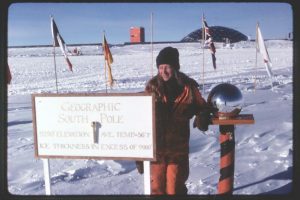August 27, 2018
Lessons Learned While on the Ice: Meet Geophysicist Martha Savage
Posted by AGU Career Center

Martha Kane Savage at the geographic South Pole in 1980. Credit: Mike Savage.
In our latest Paths Through Science, geophysicist Dr. Martha Savage explores lessons she learned during an expedition to Antarctica she participated in early on in her career. Check out additional profiles of Earth and space scientists in a variety of sub-disciplines and sectors at our Paths Through Science page, and listen to Savage’s full interview at the AGU Narratives community on StoryCorps.
Each year, a small group of scientists, engineers, and technicians embark on the arduous journey to McMurdo Station, the United States’ bustling hub for all-things-polar at the southern tip of Antarctica. Sometimes a smaller contingent will continue on to the Amundsen–Scott South Pole Station, more than 800 miles from McMurdo, at the geographic South Pole.
In 1979, Martha Savage was a part of that contingent. She was the sole woman among a team of 16 men and only the second woman to spend the entirety of the Antarctic winter on the ice, known to those in the Antarctic community as “wintering over.”
Dr. Savage, now a professor of geophysics at Victoria University of Wellington in New Zealand and an AGU Fellow, spent a year at the station as a cosmic ray observer, working to detect charged particles emanating from the Sun. However, the year that she spent on the ice taught her more than just how to manage delicate instrumentation—it also taught her valuable lessons on life, her career, and finding synergy between the two.
Discovering the Wonder of Science
Savage grew up surrounded by science, but it took her a while to develop an interest in it. She loved to read and write and initially thought that she wanted to be a writer. But her reluctance to pursue a career in science dimmed when her father, a physicist, gave her a toy chemistry kit, complete with test tubes, beakers, and all.
Savage quickly put her new tools to work. She was fascinated to learn that the calcium carbonate–based marble rocks that she had collected on a recent family trip to the mountains of Colorado gently bubbled when exposed to household vinegar.
By the time she began high school, her interest in science had grown, as she found that she was not only captivated by science but also pretty good at it. Savage excelled in her physics and mathematics coursework and was committed to pursuing a career in physics when she arrived at Swarthmore College in Pennsylvania to begin her undergraduate studies.
Getting to the South Pole
In her first year at Swarthmore, Savage and her friends noticed a departmental posting that invited recent graduates to apply for field technician positions at the Amundsen–Scott South Pole Station. They were all intrigued by the posting and jokingly agreed to apply for the opportunity in their senior year. But Savage was the only one who actually ended up applying for the position.
Three years into her physics degree, the experiential joys of science that initially had pushed Savage toward science continued to tug at her, this time guiding her toward geophysics. “I really liked the outdoors and…I was feeling sorry that I hadn’t gone into another field that would have taken me out of the lab,” she said. Spending a year in the Antarctic tundra seemed like the perfect adventure.
And in some ways, it was. Savage helped to support various exciting astrophysical and atmospheric research projects and was surrounded by the beauty of the outdoors, something that she had longed for while completing her undergraduate degree.
However, being the only woman at the station presented a unique set of challenges.
Navigating a Landscape Dominated by Men
Since the early 20th century, Antarctic expeditions, and consequently, Antarctic research, have been dominated exclusively by men. This legacy largely informed the early policies and practices of the United States Antarctic Program, as women were barred from participating in Antarctic research activities until the 1969–1970 field season.
It had been only a decade since the first group of women stepped foot on the ice as affiliates of the U.S. Antarctic research program when Savage arrived at the station—she was part of the group of bold women who were instrumental in promoting gender equity in Antarctica.
The time Savage spent at the South Pole was deeply formative, both personally and professionally, and the lessons she learned there have stayed with her far past her time at the station.
“At the South Pole, I learned that people’s character was really important, the most important thing about them,” she said. “You want to work with people who have good character…they might be the smartest person, but they might not have good character…and you don’t really want to work with them.”
This principle continues to influence Savage’s professional career, and she strives to prioritize her family in all her decisions. “I do what will be good for both my family and my career,” she said.
“You don’t have to choose something that’s just good for your career; you can choose your family.”
Danya AbdelHameid is the Summer 2018 Talent Pool Intern.


 On the Job is an AGU blog, that provides career advice and workforce guidance to geoscience students, early-career and established professionals who are interested in pursuing professional enrichment.
On the Job is an AGU blog, that provides career advice and workforce guidance to geoscience students, early-career and established professionals who are interested in pursuing professional enrichment.